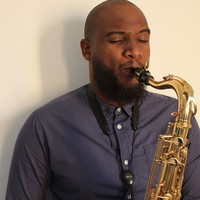- The saxophonist, educator and researcher explore contemporary music performance from 20th to 21st century in collaboration with composers and interaction on performance ensemble. Regarding the artwork, he has a critical view of the phenomenon of musical performance and its construction and development, in which seeks a reflection on the reality of current musical performance. The composition of his works involves the investigation between popular and classical music, where... moreThe saxophonist, educator and researcher explore contemporary music performance from 20th to 21st century in collaboration with composers and interaction on performance ensemble. Regarding the artwork, he has a critical view of the phenomenon of musical performance and its construction and development, in which seeks a reflection on the reality of current musical performance. The composition of his works involves the investigation between popular and classical music, where he explores improvisation, modern jazz, contemporary music and their relationships.
He has been using a variety of materials and processes in each genre to make his practice and performance consistent. However, there may not always be material similarities between the different genres they are linked by recurring musical performance concerns. As a musician and artist, he is pleased to be invited to premiere pieces in collaboration with Brazilian and international composers. The XXIX Panaroma de Música Brasileira Atual (Rio de Janeiro), Série de Concertos do studio PANaroma com PUTS and Festival Música Estranha (São Paulo) are festivals and concerts of contemporary music that he participated as a performer in Brazil. He has founder of In ensemble and has been contributing with Ateliê Contemporâneo, Continuum Sonoro ensemble (São Paulo, Brazil), UFRJ sax ensemble (Rio de Janeiro, Brazil) for interpretations solo and in ensemble (also with electronic) for 20th- and 21st-century repertoire music concerts. The musicians Alexandre Lunsqui, Gabriel Xavier, Guilherme Ribeiro, Gustavo Bonin and Laura Bowler are the main composers and contributors of his majors.edit
At the end of the 1940s, Charlie Parker (1920-1955) recorded a jazz album (Charlie Parker with strings, 1949) in which they would participate not only in the usual instrumental set of bebop, but also in orchestral instruments. Parker... more
At the end of the 1940s, Charlie Parker (1920-1955) recorded a jazz album (Charlie Parker with strings, 1949) in which they would participate not only in the usual instrumental set of bebop, but also in orchestral instruments. Parker received criticism in recording this album as a commercial product intended for the white public, contraty to the proposel of bebop that expressed the ethnic identity of the black population. However, Charlie Parker with strings allowed both the financial gain and the advertising opportunities of bebop's musical characteristics to a wider audience than originally reached at the beginning of bebop. The piece Just friends by John Klenner and Sam M. Lewis, was chosen as the first of the album, possibly being one of the most emblematic of these possibilities of commercial and advertising bebop. The works will makea analyze of Parker's solo in this piece, seeking to identify compositional improvisatory features and their relationships with bebop's idiomatic characteristics.
Keywords: Bebop; Charlie Parker (1920-1955); Just friends (song, 1931); Just friends (arrangement, 1949); Melodic analysis.
Keywords: Bebop; Charlie Parker (1920-1955); Just friends (song, 1931); Just friends (arrangement, 1949); Melodic analysis.
Research Interests:
This monograph aims to investigate improvisation and free improvisation as a pedagogical tool in the process of teaching-learning. In their practice, the rhythm was the aspect observed and developed in an action research carried out with... more
This monograph aims to investigate improvisation and free improvisation as a pedagogical tool in the process of teaching-learning. In their practice, the rhythm was the aspect observed and developed in an action research carried out with students between the age group of 11 and 12 years old, in a school unit located in Mogi das Cruzes (São Paulo). The study is based on the creative practices of pedagogues that stand out in the musical education, notably Chefa Alonso and Hans Joachim Koellreutter.
Key-words: improvisation; free improvisation; rhythm; musical education.
Key-words: improvisation; free improvisation; rhythm; musical education.
